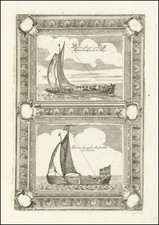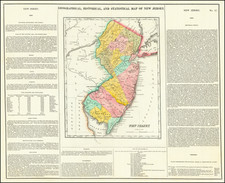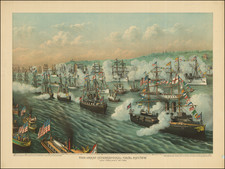Original Manuscript Charter of the First Railroad Company in America
John Stevens's New Jersey Rail Road Company, 1815
The original 1815 manuscript charter for the first railroad company in the United States - a remarkable item for the history of early American transportation technology. This charter, the first American railroad charter ever granted, was for a company to erect "a new rail road, from the River Delaware near Trenton, to the River, Raritan, at, or near New Brunswick." While this specific railroad was never built, the charter served as a model for future railroad development in the United States, as evidenced in the history of the Camden and Amboy and parallel railroad companies throughout the 1830s.
John Stevens and the New Jersey Railroad Company
The New Jersey Railroad Company, the first planned passenger railroad chartered in the United States, was the brainchild of inventor John Stevens (1749-1838), an important early American engineer and pioneering inventor in the fields of steam engines, steamboats, and locomotives. The company was granted this charter by the state of New Jersey on February 6, 1815, to "erect a rail-road from the river Delaware near Trenton, to the river Raritan, at or near New Brunswick." While the railroad was never actually built due to lack of investor interest, the present charter for the railroad is historically important for giving Stevens and his partners a virtual monopoly on railroads in New Jersey, which later extended to the Camden and Amboy Railroad and Transportation Company (C&A), chartered in 1830. The latter company used a pioneering railroad and canal system designed to connect the Delaware River (for access to Philadelphia), with the Raritan River (for access to New York City).
The charter comprises fifteen paragraphs, the contents summarized, as follows:
Upon the meeting of basic financial requirements, the act provides for the organization of "The New Jersey Rail Road Company" which "shall have all the powers and privileges incident to a body politic and corporate...for the term of fifty years..." Capitalization was $500,000. The charter grants to James Ewing, Pearson Hunt and Abner Reeder a commissionership "to receive subscriptions for erecting a rail road...such subscriptions shall not exceed five thousand shares of one hundred dollars each..." The route was to be surveyed and mapped, and a system of appraisal and arbitration was established to fix payment for the land of the right of way, in case the owner and the railroad could not agree. Paragraph 6 gives general specifications for the construction of the roadbed; the rails were to be of iron or wood, and specific mention of "the middle path ... to be good at all seasons of the year" would imply that horse power was contemplated as the motive power, though this is not stated, nor is steam power proscribed or prescribed. Public and private crossing are ordered. A State commission is to determine freight and passenger rates, so fixed as to give a return of 12 percent on capital invested.
The planned route of the New Jersey Rail Road would have connected the water ports, allowing ferry boats to take riders the last distance connecting Philadelphia and Trenton to New York City and Brooklyn and Queens on Long Island via New York Harbor, as proposed by Stevens.
The final page of the charter is signed by William S. Pennington, the sixth governor of New Jersey, and a noted early American jurist, and Samuel Pennington, Speaker of the House of Assembly. The document is also signed by James Say, and James Wilson. Though the name of John Stevens does not appear in the charter, it is well known that he was the primary person behind the proposed railroad.
An important item of manuscript Americana and an amazing document for American railroad history, being the genesis of what evolved into one of the most successful early railroad systems in the United States.
Provenance
Charles Hamilton Autographs, Inc. Sale No. 14. The Waldorf Astoria Hotel, September 22, 1966;
H. P. Kraus












![[ Virginia Natives -- The Conjurer ] Praestigiator](https://storage.googleapis.com/raremaps/img/small/98754.jpg)


![[ Volcanic Area -- Phlegraean Fields ] Mirabilium Sulphureorum Motium Apud Puteolos (campos Flegreos Plin Vulcani forum Strabo Vulgo nunc Solsataria vocant Neapolitani) genuina accuratissimaq ad Viuum depcita representatio](https://storage.googleapis.com/raremaps/img/small/96872.jpg)
![Marine, Vaisseau de Guerre avec toutes ses Manoeuvres et Cordages [Navy, Waship with all her Ropes and Riggings]](https://storage.googleapis.com/raremaps/img/small/88590.jpg)